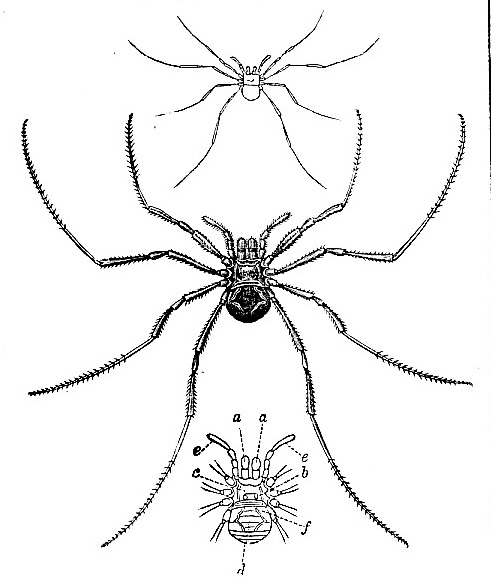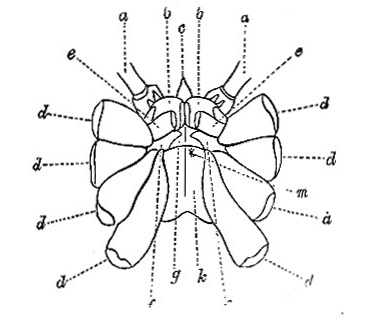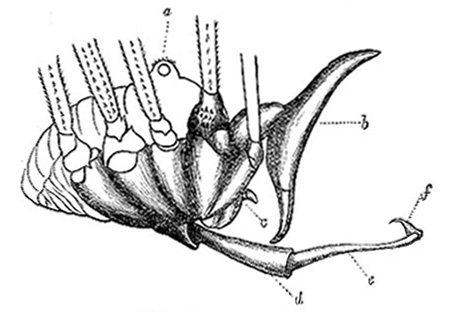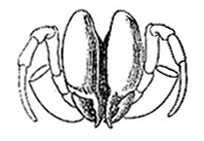(11) ARACHNIDA - ORDER III: PHALANGIDEA - GENERAL OBSERVATIONS
GENERAL OBSERVATIONS. - The Phalangidea have been found in all parts of the world, but though often very numerous in individuals, the number of species as yet discovered is comparatively small. In the British Islands, where about sixteen species have been observed, they are popularly known by the name of "Harvest-men," probably because most numerous at the time of harvest. They run with great rapidity over and among grass and low herbage, and many live among the leaves and mossy covering of trees, among moss on the ground, heath, and stems of herbage; also under stones, and among rubbish and debris. Their prey is small insects, the young of the true spiders, and some species of Acaridea. The small size of the body, compared with the inordinate length of the legs, in some genera is exceedingly striking. In an undescribed species of Leiobunus, from the Brazils, the length of the body is but a line and a half, while that of the longest legs exceeds fifty lines; being in the proportion of about 1 to 32. phalangids part easily with their legs, or with portions of them; and when detached these legs retain the power of motion for a considerable time, due probably to sustained nervous energy. The order may be divided into about four well-marked families.
Fam. I. Cyphophthalmides. - Characterised an oval, flattened body, short legs, with undivided tarsi; falces projecting far in front of the fore part of the caput, and three-jointed (Joseph). Eyes on pedicles, one on each side of the cephalo-thorax near the lateral margin. One genus only, Cyphophthalmus (Joseph), and two species, C. duricorious (Joseph), and C. corsicus (Simon), have as yet been discovered, both of very small size, and both South European. They have an exceedingly acardian appearance, and seem evidently to connect the acarids with the more typical Halangidea. See G. Joseph (Berl. Ent. Zeitschr. 1868, pp. 241-250 and 269-272), who speaks of but two tracheal stigamata; probably the thoracic stigmata were overlooked. The form of the maxillae appears to be peculiar.
Fam. II. Trogulides - Somewhat similar in general appearance to the former family, but differing in the parts of the mouth being concealed beneath a kind of hood, which projects beyond the fore margin of the cephalo-thorax; and in the eyes, which are placed, well separated, in a transverse line at the constriction, where the hood joins the caput. Two genera, Cryptostomma (Guerin) and Trogulus (Walck), have been characterized; of the former one species only is yet known, C.Westermanni (Guer.) Guinea. Of the latter genus the species are few, all little appears to be known of their habits or economy; one only, of small size, Trogulus Cambridgii (Westwood), has been found in England (at Bloxworth, among moss, by the Rev. O. P. Cambridge), remarkable from the dense clothing of short squamose hairs on the body, and hooked spine-like bristly hairs on the legs.

Fig. 10 -- Phalangium copticum, Savigny. a, a, falces; b, eyes; c, cephalo-thorax; d, abdomen; e, e, palpi; f, junctional line of cephalo-thorax and abdomen.

Fig. 11 -- Phalangium aegypticum, Savigny; under side, with legs and palpi truncated, and without abdomen. a, a, palpi; b, b, maxillae; c, tongue; d...d, first joints of legs; e, e, f, f, supernumerary maxillae, supporting first two pairs of legs, and used in eating (?); g. membranous lip (labium); k, sternal plate (sternum); m, fore-margin of sternal plate, under which (at *) are sexual organs.

Fig. 12 -- Harvest-man (Phalangium cornutum, Linn.); profile, with legs and palpi truncated. a, eye eminence; b, falces; c, portion of mouth apparatus; d, sheath of penis protruded; e, penis; f, the glans.

Fig. 13 -- Falces and palpi of Phalangium copticum.
Fam. III. Phalangides (figs. 10, 11) - Characterised by their small, round, oblong, or oval body; exceedingly long, slender, legs, with multi-articulate tarsi; eyes close together, one on each side of a tuberculous eminence on the vertex of the cephalo-thorax (fig. 12, a); the eminence, as well as other parts of the body, often armed with spines. Falces (fig. 13) often of great size and length, the terminal joint articulated sometimes at its end, sometimes further on. Several genera of this family have been characterized, and numerous species recorded, mostly European, but our space will not permit of further details, which may be found in the work of Herman before noted, undr Acaridea; also, in those of Latreille, Sur l'Histoire des Insectes connus sous le nom de Faucheurs (Phalangium) (pub. 1802), and Herbst; in Natursystem der ungeflugelten Insekten, 1798-99; P, Gervais, in Walck. Ins. Apt., vol. iii. p. 9; and Koch, in Die Arachniden, 1831-1848; and in numerous isolated papers by various later authors. Most of the anatomical details known of the order Phalangidea have been obtained from species of this family.
Fam. IV. Gonyleptides. - This differs from the last in the generally more or less quadrangular form, or roughly diamond shape; the cephalo-thorax is proportionally larger, often appearing almost entirely to overwhelm the abdomen; it is also more spinous and tuberculous; the palpi are longer, some joints often of great strength and length, and armed with strong spines, sometimes assuming with the strong terminal movable claw, a raptorial appearance. The legs are shorter and stronger, and those of the hinder pair are usually armed with spiny processes, tubercles, and spines; the coxal joints being often inordinately developed, reaching to the extremity of the abdomen, to which, as well as to the cephalo-thorax, they are immovably attached. The tarsi are not multi-articulate. The species are tolerably numerous, and all exotic. Several genera have been characterized, on the species of the chief and typical one of which, Gonyleptes (Kirby), a Synonymic List, with descriptions of some new species, has been published by Mr. A.G.. butler, in Ann, and Mag. N.H., Feb. 1873, pp. 112, 117, pl. 3, continued in Jour. Linn. Soc. 1874, vol. xii pp. 151-155, pl. 8. Some of the works quoted on Phalangides also tr eat of this family. H.C. Wood, jun., considers the order generally in Trans. Amer. Phil. Soc. U.S. vol. xiii. Pp. 435-442 pl. 24
Read the rest of this article:
Arachnida - Table of Contents
|



